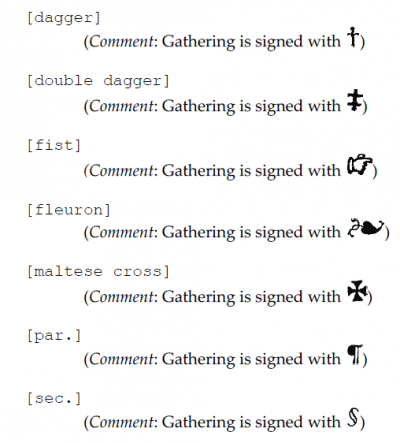Signature statements
This article reproduces an excerpt of Descriptive Cataloging of Rare Materials (Books) (usually referred to as DCRM(B)) concerning signature statements in catalog records, along with (eventually) notes and observations on Folger practice.
DCRM(B) on signatures
7B9. Signatures
7B9.1. General rule. Make a note giving details of the signatures of a volume, if considered important. Give these signature details according to the formula in Philip Gaskell's A New Introduction to Bibliography (see p. 328-332), insofar as typographical facilities permit. Preface this note with the word “Signatures” and a colon.
- Signatures: [A]4 B-C4 D2 E-G4 H2
- Signatures: A-C4 D4(-D3) E-F4
- Signatures: A-2Z8, 2A-M8
- Signatures: [1-68]
- (Comment: Volume is completely unsigned)
It is generally desirable to give signatures for incunabula, especially if identical signatures are not given in a standard bibliographic source. It is also desirable to provide signatures when a volume has no pagination or foliation.
7B9.2. Unavailable characters. If the gatherings are signed with a mark of contraction (see 0G8.2, Appendix G3) that cannot be reproduced using available typographical facilities, substitute the spelled out form and enclose it in square brackets.
- Signatures: )(8 a-z8 &8 [con]8 [rum]8
If the gatherings are signed with other unavailable characters, substitute a descriptive term or an abbreviation for that term if a standard one exists.
7B9.3. Special uses of pi and chi. Indicate unsigned leaves that fall outside the signature sequence (see Gaskell, p. 330) by using the words pi and chi. Do not enclose the words in square brackets. Do not use the Greek characters π and χ, as these will give the impression that the leaves have actually been signed with Greek letters (see 7B9.9).
- Signatures: pi4 A-C4 chi2 D-Z4
Indicate partial duplications of an alphabet (see Gaskell, p. 331) by using superscript pi and superscript chi or, if superscript letters are not available, by substituting “[superscript pi]” and “[superscript chi].”
- Signatures: piA4 A-D4 chiD4 E-F4
or
- Signatures: [superscript pi]A4 A-D4 [superscript chi]D4 E-F4
7B9.4. Non-conventional Latin alphabet. If the gatherings are signed with roman letters according to a pattern other than the conventional 23-letter Latin alphabet (i.e., A-Z, less I or J, U or V, and W), make this explicit by recording the additional letters in the signature statement.
- Signatures: A-V4 W4 X-Z4
- (Comment: Printer used a 24-letter alphabet)
- Signatures: A-I8 J8 K-U8 V8 W8 X-2I8 2J8 2K-2M8
- (Comment: Printer used a 26-letter alphabet)
7B9.5. Signatures do not match gatherings. If it can be determined that the signing of the volume does not match its actual gatherings, indicate this in the note.
- Signatures: [1]8 2-38; volume actually gathered in twelves
7B9.6. Concurrent signatures. If the volume is signed using two concurrent sequences, provide both sets of signatures in the note. Give the signatures that correspond to the actual gatherings first, if this can be determined.
- Signatures: 1-1212; also signed A-S8
- Signatures: 1-1212 and A-S8; actual gatherings cannot be determined
